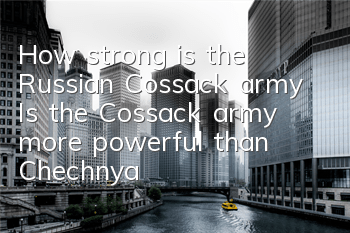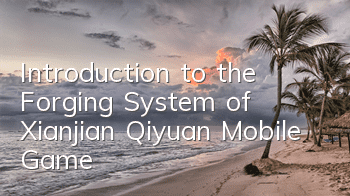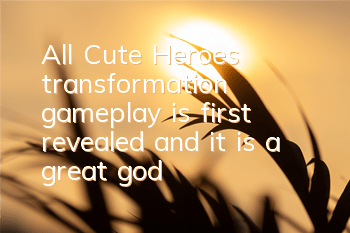Putin's last ace is not the Chechen army, but this nation that is more brave than Chechen
At the beginning of the Russian-Ukrainian conflict, videos of Chechen armed forces gathering were circulated online. The soldiers in the audience were all bearded, with a strong figure and a super flaming momentum, and looked very combat-effective.
However, perhaps beyond many people's expectations, the Chechen troops are not the last trump card in Putin's hands.
Russia also has a more fierce force than the Chechen armed forces, and this force is the Cossack armed forces.
If you want to know how brave the Cossack armed forces are, you have to mention the bloody battle during the Second Chechen War!
In 1999, 90 Cossack airborne troops were ordered to airborne a highland in Chechnya. What they needed to fight were 2,500 fully armed Chechnya separatists. In terms of quantity, this is a battle without any suspense, but these 90 Cossack warriors have made a "super god record" - annihilated more than 1,000 Chechen bandits, including the leader of the legion.
To the end of the battle, there were only 6 left in this Cossack airborne squad...
This battle brought out the morale of the Russian army and Putin's prestige. The Cossacks were like a sharp knife, tearing open the deadlock on the battlefield and tearing the "heart" of the Chechen rioters.
More importantly, what makes this army scary is not the advanced weapons and equipment, but the iron fighting spirit that has been tempered through thousands of hard work.
So, what kind of culture does the Cossack nation, which is stronger than the Chechen nation have? Why are they willing to serve the Russian regime? Today, let’s reveal how the Cossack nation, which was born warlike and free, became Russia’s sharpest blade!
一
We have to mention the origin and history of change of the Cossacks first.
Cossacks" originated from ancient Turkic language and is translated as "the wandering warrior" or "the brave explorer". However, to be precise, the early Cossacks could not be called a nation because their origins were very complex.
Around the 13th century AD, the Southern Russia-Eastern European prairie gradually became a "three-no-control" area. The ethnic structure here is extremely complex. In addition to the immigrants from Kievan Rus, there are also a large number of Germans, Ross, Turks, Tatars, etc. gathered.
Most of the people who come here are not good people, either refugees, serfs, or prisoners sent to the frontier. Such a group of people gather on this grassland without traces of modern civilization will naturally give birth to a tough atmosphere of "doing if you don't accept it".
Thanks to the fertile soil of the plain here, the agriculture here is very developed, sufficient food guarantees people's lives, the vast grasslands have fattened war horses, the rich minerals have forged weapons, and the resource conditions are very superior.
There are no explicit laws here, and there is no feudal regime. You can rely on fists and axes to reason, and you can rely on education. The people's customs are quite tough.
Among them, people with strong combat capabilities will organize together to occupy various hills and villages to form the earliest "Cossack" armed forces.
This naturally attracted the attention of others - Poland in the east and Tsarist Russia in the west were both eyeing the fertile soil here.
At that time, Poland was still quite strong, and Russia was at least the nominal successor of the Eastern Roman Empire. They did not take the powerful ones seriously in the face of the weak and powerful ones.
However, the Cossacks slapped them hard.
The Cossacks had extremely high fighting will. Although the troops were mainly light infantry and light cavalry and lacked heavy firearms, they were good at building fortifications in a short period of time and were able to carry out guerrilla warfare among the mountains and forests based on favorable terrain.
Relying on its own flexible tactics, the Cossacks took off the wings of the Polish winged cavalry and seized the muskets of the Russians.
The collective blossoming of the battlefields on both sides of the east and west formed the basic prototype of the independence of the Cossacks, which was also the first time in history that the Cossacks had beheaded and exposed their horns.
But such glory is always short-lived. Relying solely on combat and not developing civilization will eventually be swallowed up by the new wave of the times.
At the beginning of the 16th century, the Mongol branch of the Golden Horde declined, and the Tsarist Russian Empire rose rapidly with its increasing accumulation of land wealth; on the other hand, Poland accumulated huge wealth by exporting food to Western Europe; at the same time, the Ottoman Empire, which emerged on the southern flank, was eyeing it.
This time, it was the Cossacks' turn to be "beaten".
Faced with endless powerful troops on three sides, batches of Cossacks fell under more advanced muskets.
Because there was no decent feudal regime in the local area, the defeated Cossacks became prisoners of other countries, either became mercenaries for the expansion of Polish nobles to the outward expansion; or surrendered to Tsarist Russia and became the vanguard of Tsarist Russia's western throne.
In such a divided situation, the Cossacks began to split into two camps, most of which were "pro-Polish factions" in the west and "pro-Russian factions" in the east. The two factions were incompatible, and such a split environment continued to this day.
Before the outbreak of the Russian-Ukrainian conflict, Ukraine's pro-European and pro-Russian factions were affected by historical factors.
Cossack City-State
In the 18th century, the Cossacks also enjoyed a certain degree of territorial autonomy; but by the 18th century, the Cossacks' autonomy was blatantly abolished, and the ruling area was also downgraded to a general province.
Before the outbreak of World War I, the Cossacks only existed in name, but although the land and country no longer existed, the fighting spirit of the Cossacks had been well preserved, and their descendants also claimed to be the Cossack nation.
WithThe "October Revolution" broke out in Tsarist Russia, and a few Cossacks who were still wandering were standing on the side of the Soviet Red Army.
In the years of battle, the Cossacks fought bravely. They spontaneously formed a strong cavalry armed group and reorganized into the First Cossack Cavalry Army under the Southwest Front in 1920, dedicating their lives and blood to the first socialist state regime in human history.
However, in the early days of the founding of the Soviet Union, the fate of the Cossack nation was not rewarded as it deserved.
After experiencing the "Great Ukrainian Famine" and the "DeCossackization Movement", the physical and mental health of the Cossack nation suffered a double blow, and the population and wealth of the entire Cossack nation suffered huge losses. This situation did not improve until 1936.
2
In 1936, Soviet leader Stalin ordered the lifting of various restrictions on the Cossacks, and even allowed the cavalry regiment formed by the Cossacks to retain the uniforms and military characteristics of the Tsarist Russian era.
Why did the Soviet Union's attitude towards the Cossack nation suddenly turn from shady to sunny? It's very simple, because there's a war again.
After the outbreak of the Soviet-German War, the Cossacks joined the red wave of anti-fascist forces. The Cossacks, like their ancestors, still participated in the battle with cavalry. In the extremely long strategic depth, the Cossacks showed extraordinary power. These Cossacks held anti-tank grenades and were ready to go under their crotch, dealing with German tanks on the front battlefield.
In addition to field battles, the Cossacks also showed the courage of their nation in street battles with extremely high casualties.
Especially during the Stalingrad defense war, the Soviet Red Cossacks fought position wars with the Germans in narrow streets and buildings. They used floors and streets as basic position units to block the rage of firearms with flesh and blood.
After the victory of the Battle of Stalingrad, the Cossack folk songs resounded in the ruins of the city.
Yes, the spirit of the Cossacks has never perished, and they are still a sharp knife in the middle of the war.
At the stage of strategic counterattack, the Cossacks were still charging at the forefront. They once again crossed the Dnieper River, followed the charge of Baglation, and headed straight for Berlin.
When the Soviet flag was planted in the Berlin Congress building, the Cossacks once again regained their former glory.
After the end of the war, many Cossack veterans often recalled:
"In the First Patriotic War, we Cossacks took the lead in rushing into Paris, and in the Second Patriotic War, we Cossacks took the lead in rushing into Berlin."
This war made the Cossacks remembered by history again. The Cossack cavalry that ran on the battlefield had become a cultural symbol representing freedom and romance in modern European literature.
After the end of World War II, the Cossack nation finally ushered in long-term peace with its outstanding achievements.
Over the past few decades, the Cossack army has gradually formed a complete combat system from its formation to its fixedness. Its combat style is the most fierce among the entire Soviet and Russian armies. They are specifically responsible for the most difficult battles and are not afraid of the price of sacrifice.
During the Second Chechen War, the Cossacks also taught Chechen a lesson.
This brings up the scene we talked about at the beginning.
Three
In today's Russia, there are about 140,000 registered Cossacks, but there are far more people who claim to be descendants of Cossacks among the people than this number. The bond that connects every Cossack people is the fighting spirit that their ancestors yearn for freedom for generations.
Today's Russia follows the Soviet tradition and retains relative independence from the customs of the Cossack nation.
If the Cossacks were willing to serve Russian official duties and military, they could become "Registered Cossacks of the Russian Federation."
In non-war periods, most registered Cossacks were engaged in national security protection tasks. Some of them guarded forests and wild animals around the villages, and some were specifically responsible for protecting Russian cultural heritage in cities.
If you enter a wartime state, the registered Cossacks will form a vanguard army at any time, becoming a powerful force to defend the country.
Today, the vast majority of Cossacks still maintain traditional agricultural and animal husbandry life. Although they have experienced so much, they must not regard today's Cossacks as a combat nation that cannot be seen in big words.
In contrast, the cultural level and education level of the Cossacks gathering areas are generally high, and the crime rate in the area is also low. Others not only have force, but also have martial ethics.
Today's Internet people compare Russians to "combat nations", but in my opinion, this statement is biased. In my opinion, almost any nation in the world today has its own fighting will.
The same is true for the Cossacks, who, like any nation on earth, love peace and are not afraid of fighting.
Although the highlights left by the Cossack nation are almost all related to combat, no one is a natural warrior, and every warrior is fighting for his own beliefs. Similarly, no nation is born warlike. What they need is just a glance of clean springs, a fertile land, and a home on which to survive.
Therefore, when evaluating the Cossacks, we should fully understand its history and spirit. The Cossacks used battle to apply their spiritual totem, and this spirit is worth remembering and respecting.
Now war once again writes the history of Eastern Europe, BrotherWhether the Saks will remain faithful and fight firmly, let us wait and see.









